Published: Friday 21st November 2025
The Netherlands
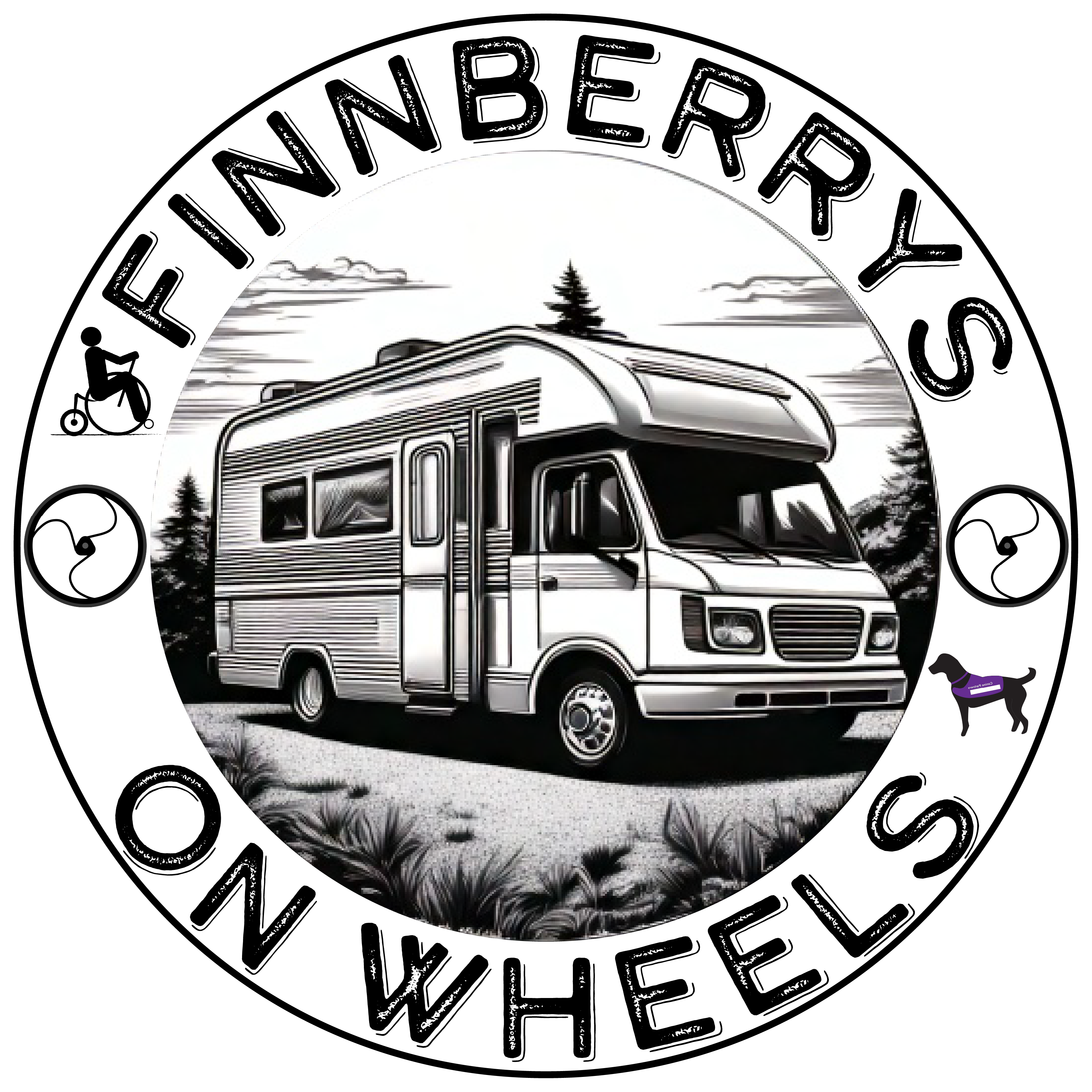 Now that we have a logo, I thought I'd use it on my blogs to indicate when the subject is going to be travel related. Many of my blog posts are about digital accessibility, and this is likely to remain my focus, but we love travelling in our motorhome and physical accessibility in relation to travel is important to me. So posts with the Finnberrys on Wheels logo, will be travel posts.
Now that we have a logo, I thought I'd use it on my blogs to indicate when the subject is going to be travel related. Many of my blog posts are about digital accessibility, and this is likely to remain my focus, but we love travelling in our motorhome and physical accessibility in relation to travel is important to me. So posts with the Finnberrys on Wheels logo, will be travel posts.
We have recently returned from a fantastic holiday touring the Netherlands. We only had a week, so we didn't cover the whole country but the places we did visit were really enjoyable. I may write about the whole experience and publish a book on Kindle. In this blog post, I want to reflect on accessibility of the Netherlands.
North Sea Ferries
Living in the East Riding of Yorkshire, the Hull to Rotterdam route that P & O run, is a really attractive route into Europe. From home to the port is less than an hour's drive, so it means we can get off on our main holiday much quicker than we would if we had to drive to the south coast first.
What was good about P & O Ferries?
We had booked an accessible cabin and it was perfect for my needs. It was the standard inside cabin, so didn't have a window, but it was very roomy and had plenty of space for my wheelchair and Liggy's bed. The beds were comfortable and the pillows were nice and plump.
The bathroom had grab rails all around the toilet and shower. I showered in the morning and it had good pressure and nice hot water. The drainage system prevented the whole floor getting wet, which helped reduce the risk of slipping.
We had dinner and breakfast in The Kitchen, which is an all you can eat buffet restaurant. Staff were very helpful in there. They got us seated at a table with enough space for my wheelchair and a safe place for Liggy to lie next to me. The food was lovely, though I would be very concerned about cross-contamination if either of us had serious food allergies.
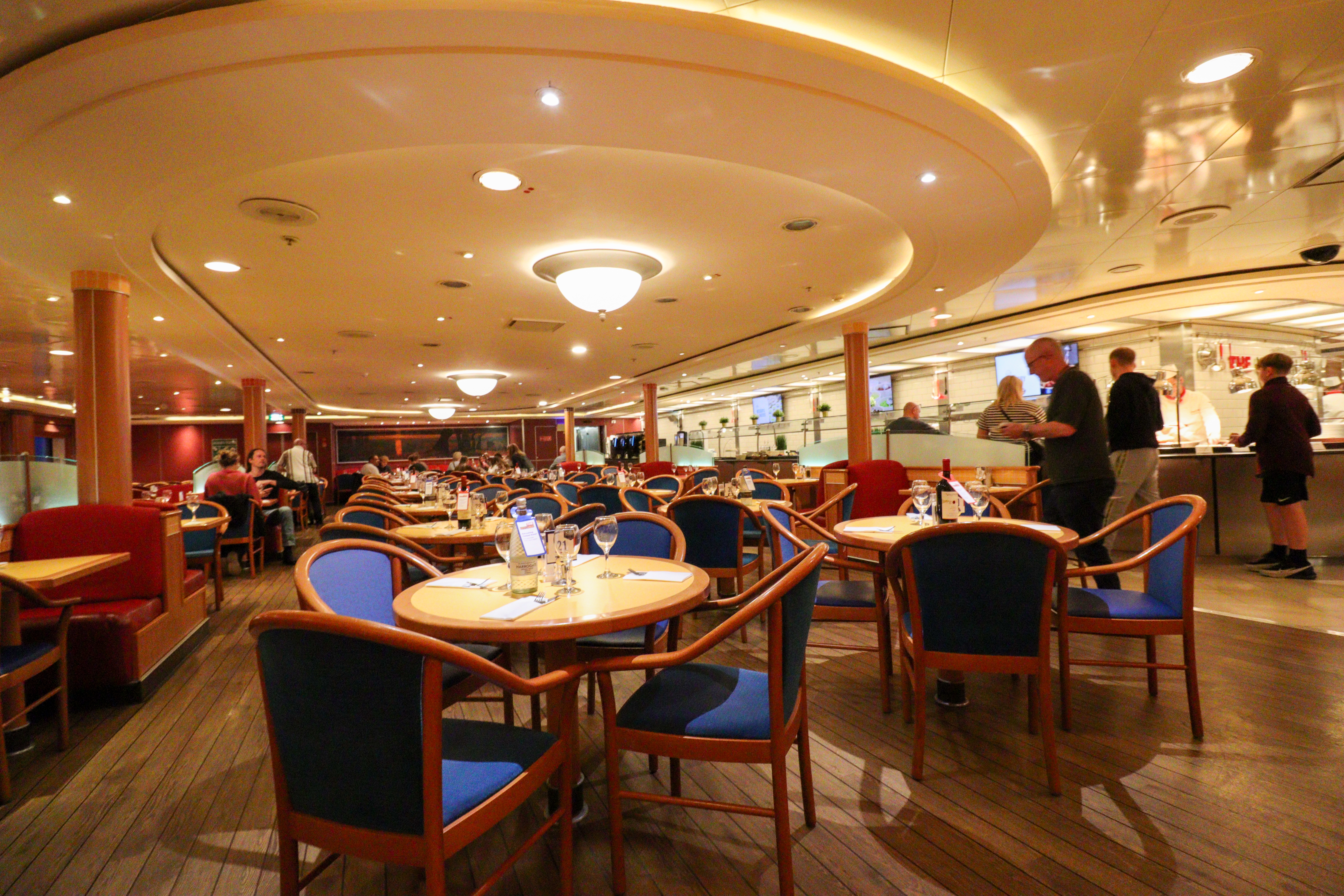
What was bad about P & O Ferries?
Let's start with the booking system. When you select the number of passengers travelling, you have to also select Special assistance required. This triggers a drop-down list that you can choose from.
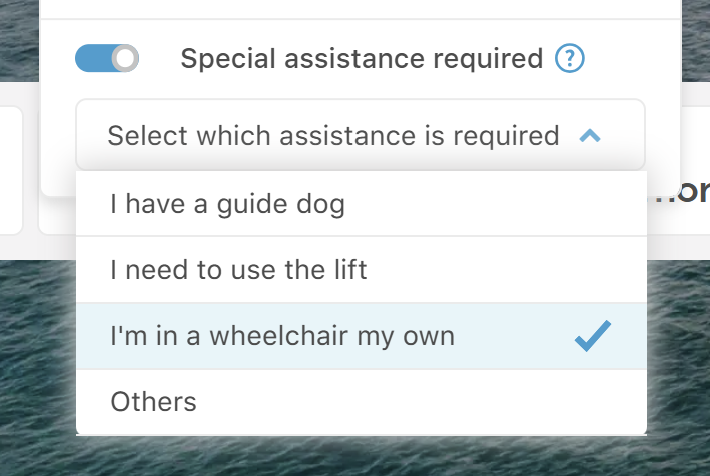
If you need to book an accessible cabin, you have to select I'm in a wheelchair my own. This means it is not possible to select I have a guide dog. The problem with this is that all dogs must, by law, be registered on the booking. I did email and telephone to let them know I have an assistance dog, but Liggy wasn't added to the booking. This resulted in a lot of stress on both journeys, as they had no record of her.
Related to this, P & O use the term guide dog rather than assistance dog. Firstly, this can cause confusion because Liggy is not a guide dog, so when I'm asked if she's a guide dog, my initial reaction is, "No." Secondly, it reinforces the incorrect view that only guide dogs have access rights. This is absolutely incorrect. Gov.UK ![]() makes it clear that all recognised assistance dogs must be allowed to travel with their disabled human, and it even specifically mentions those with reduced mobility.
makes it clear that all recognised assistance dogs must be allowed to travel with their disabled human, and it even specifically mentions those with reduced mobility.
Whilst the inside of the ship was pretty accessible, getting outside was really difficult. Our accessible cabin was on deck 8, which was great for the restaurant but there is no deck access from deck 8. Dogs must be toileted on deck 7, but there is no lift access to deck 7 once at sea. This meant that I couldn't take Liggy to the toilet and Neil had to take her for me. Asking her to toilet on a deck is not a natural place, so adding in the additional stress of leaving me behind really wasn't ideal. Fortunately, she coped but getting her to do her business in the right place was tough on Neil.
On deck 10, there is a general outdoor area, but that is also the smoking deck. However, it was the only outdoor space that was even remotely possible for me. Getting out there involved hurdling a large bulkhead, which Neil had to help me with. I had to get out of my chair while he lifted it over for me. We managed it okay, but we were both a bit baffled about the need for such a large bulkhead. Deck 10 was so high up that if water was coming in there, the whole ship would presumably be in serious trouble anyway.
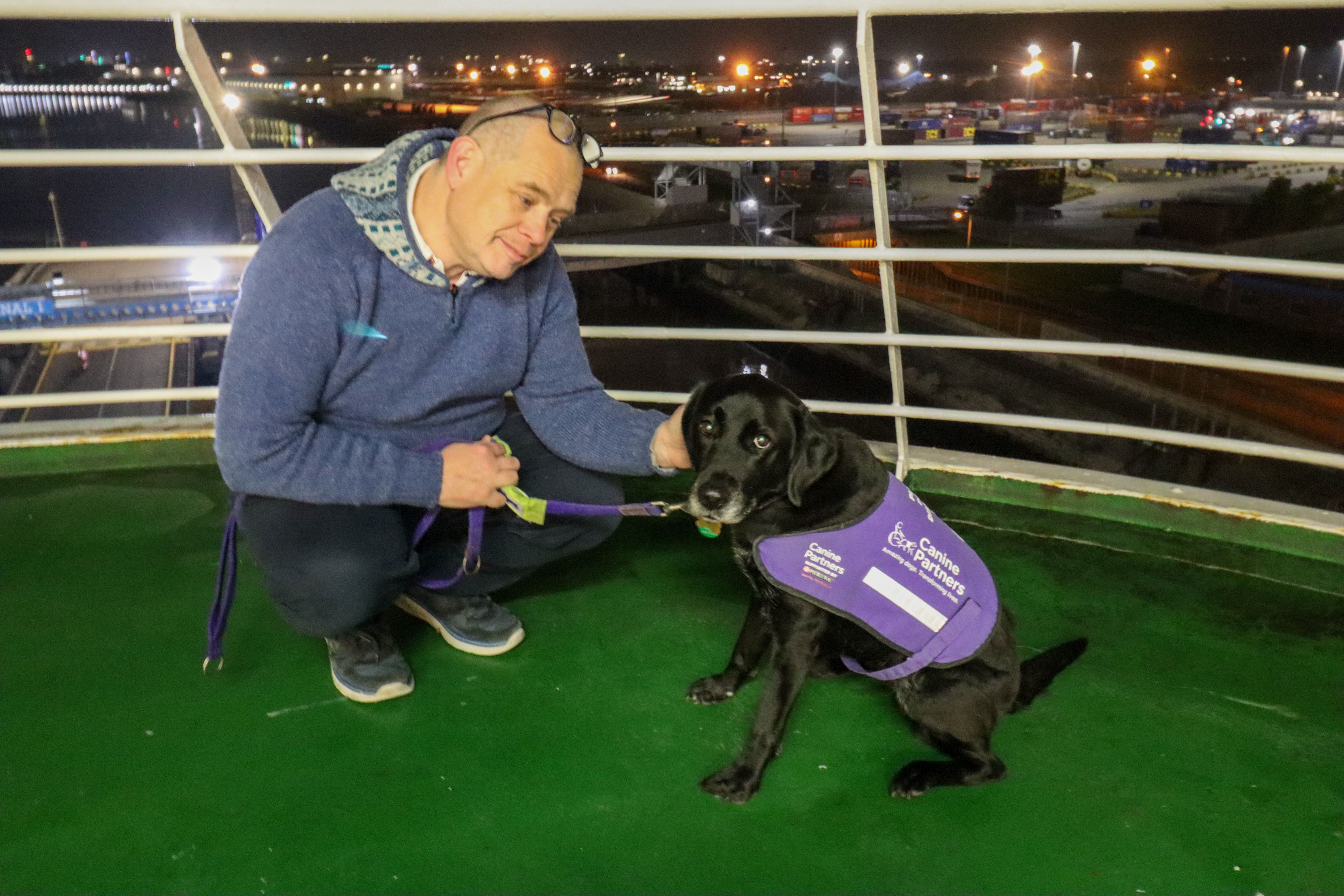
Rotterdam
What was good about Rotterdam?
Rotterdam is a really interesting city! It was completely destroyed by German bombs during World War 2, and rather than rebuilding to make everything back like it was, they completely redesigned the whole city. Some of the architecture is very quirky and clever. We particularly enjoyed the Markthal area and the Cube Houses.
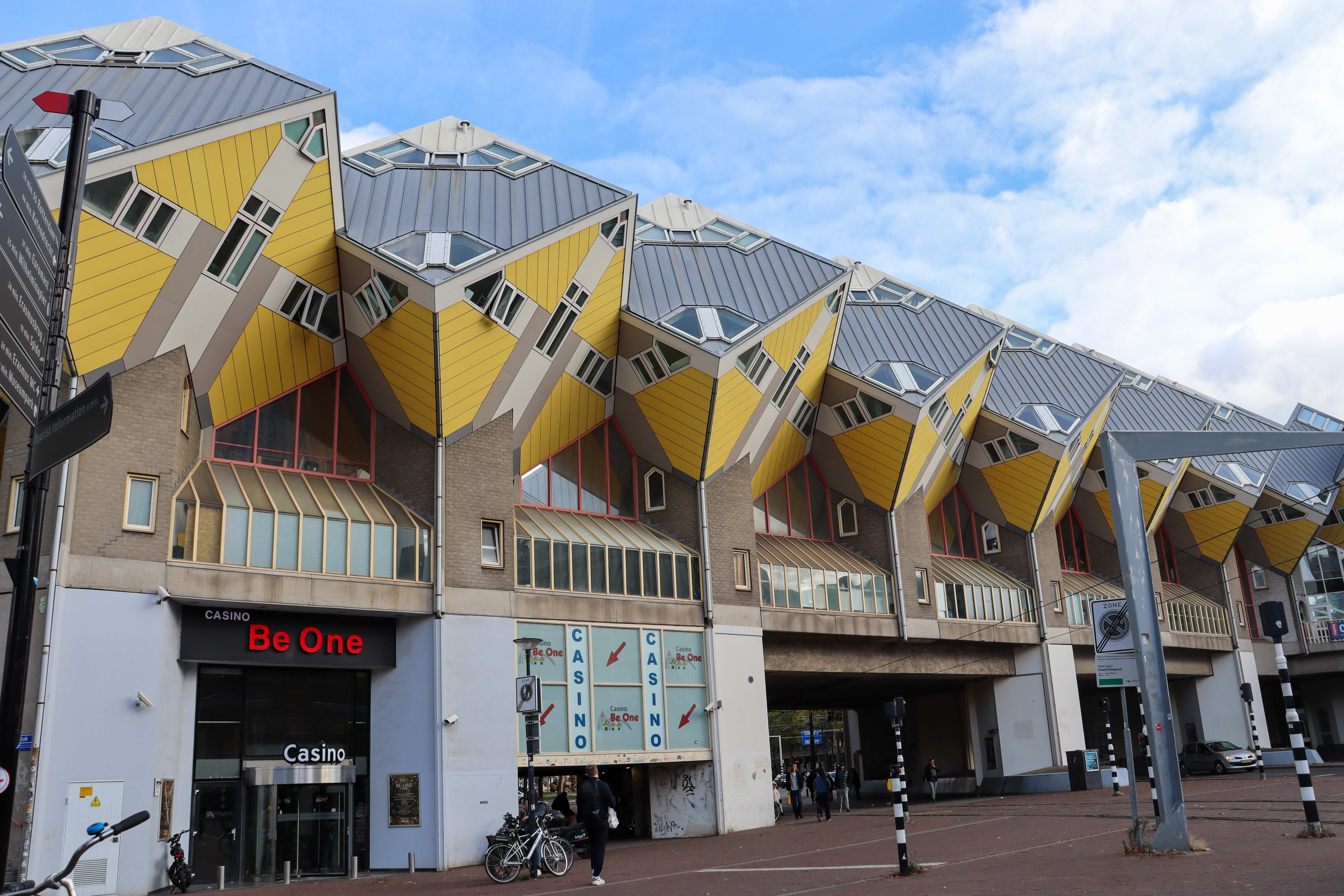
We enjoyed walking through Het Park and along the riverside towards the market area. It was our first experience of walking in the Netherlands, which is so easy because it is almost completely flat.
We had lunch in the Markthal, which was very tasty indeed. This is the biggest food hall in Europe and you can find almost anything you fancy here. We had a list of traditional Dutch foods that we wanted to try. We found a fish stall and had kibbeling, which is small pieces of cod, deep fried and served with a tartare sauce. We shared one portion of kibbeling and one of calamari. It was delicious and really boosted our energy levels, ready for walking through the city.
What was bad about Rotterdam?
Parking a motorhome in Rotterdam was really difficult! Many cities have designated parking, even if it is quite a long walk from attractions. Rotterdam doesn't. I had done tons of research and found some street parking but it was our first visit of the holiday and it was quite stressful, trying to find a suitable parking place in a residential area of a city and then deal with street parking machines in Dutch.
I think our biggest disappointment was Euromast. I remembered going here as a child and really enjoying it. However, wheelchair users can only go to the viewing platform, not up the twirly lift. Given that, we felt that the €46 entry ticket was utterly extortionate! It really wasn't worth it and we wouldn't recommend it. That said, the weather was beautiful and the views were good.
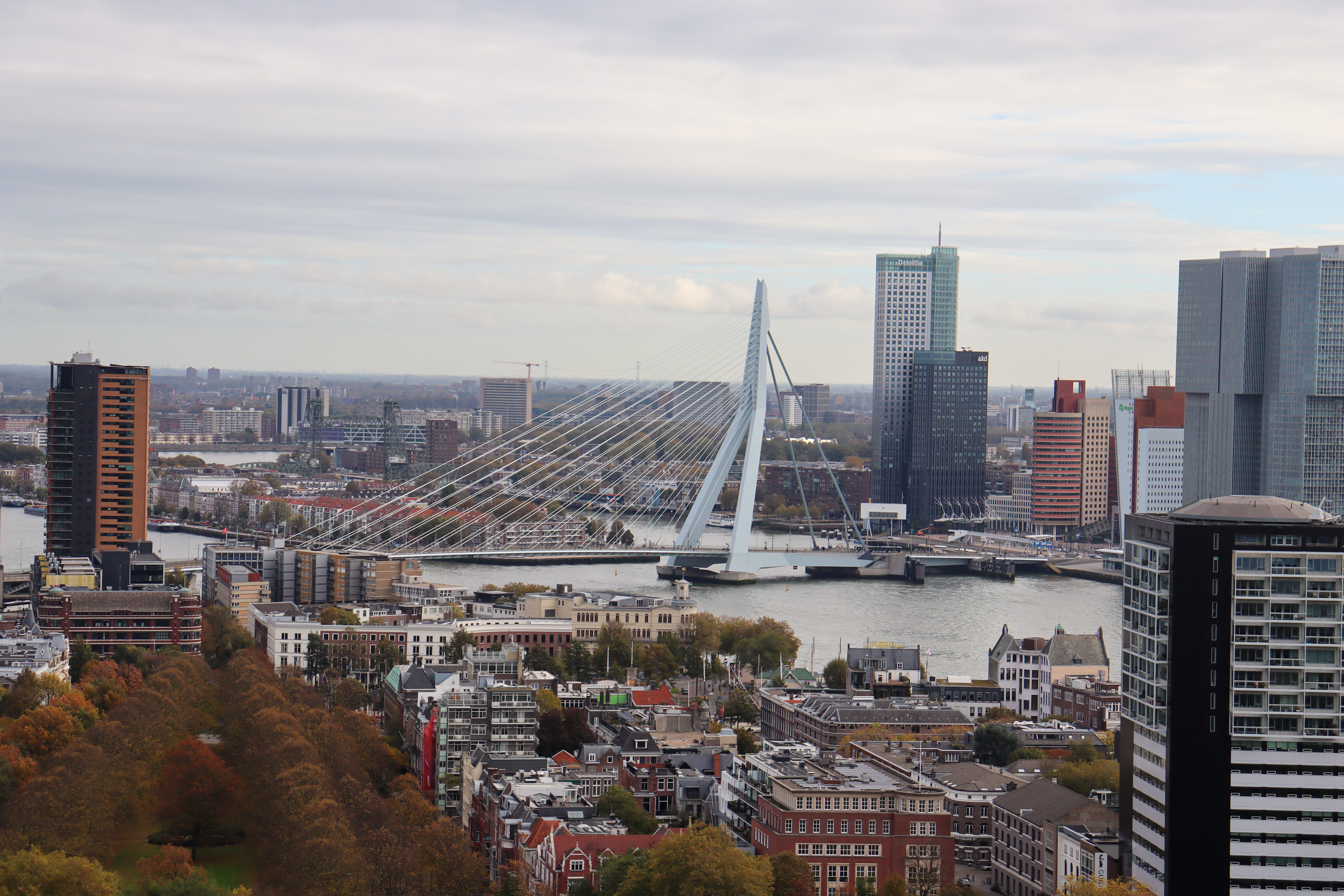
Delft
What was good about Delft?
Let's start with the campsite. We stayed two nights at Delftse Hout Campsite and really liked it. The site itself felt safe and secure. It was clean and welcoming. We felt that the pitches were a little too close together and the access roads too narrow, but once we got set up, we left the motorhome in place and walked everywhere.
The main place we wanted to visit was Royal Delft - the porcelain factory and museum. This was a good 40 minute walk from the campsite, which we broke up with a visit to the Botanical Gardens (about half way there). Although it was quite a long walk, the pavements were mostly good, with dropped kerbs and crossing points easy to find.
We really enjoyed Royal Delft. In terms of wheelchair access, it wasn't perfect but it was pretty good. I think it was here that we began to realise that the Netherlands doesn't seem to have rules or laws around gradients of ramps. The existence of a ramp defines accessibility, not the likelihood of someone being able to use it!

We found the museum really interesting and loved looking at all the beautiful pottery. There were a couple of workers painting in the factory area, which was mesmorising to watch. The shop was amazing! You could easily spend thousands of euros in there! We restricted ourselves to an eggcup and a Christmas tree decoration. Then we had lunch in the cafe, which ticked off another Dutch food - poffertjes - a kind of tiny pancake covered in butter and icing sugar.
We thoroughly enjoyed walking around the City of Delft. It was really pretty, with canals, bridges and traditional buildings. We were particularly taken by the old church, which has a large spire that leans quite significantly to the side.
What was bad about Delft?
I think the only disappointment in Delft was a coffee shop. When we arrived at the campsite, we received a voucher for a free cup of coffee each at Stads Koffy Huis. We found it, and it definitely wasn't wheelchair accessible. They did have some outside seating though, so we made the best of that. The waiter wasn't very polite or helpful, leaving us feeling like a bit of an inconvenience.
Once seated, we waited to be served. After a while, Neil ventured inside, wondering whether we had to order at the till, but was told we would be served at our table. We almost gave up waiting but eventually, the waiter reappeared. I asked him if we had done something wrong. He said that he'd just forgotten about us.
The service was frankly terrible but the coffee and apple pie were very tasty. Such a shame, as we would definitely not recommend them to anyone else, free voucher or not!
The Hague
I should start by clarifying that we didn't actually go into the Hague itself. We visited Madurodam and then walked through a huge park called Scheveningse Bosjes, to the Peace Palace.
What was good about The Hague?
Madurodam is a miniature village... well actually, a miniature Netherlands. It's vast! I thought it was really good in many ways. Like other places, ramps were a little steep but I was able to get around the entire park, which I enjoyed. Toilets and restaurants were clean and easy to access. We were there during half term holidays, so it was busy, and there are many working trains and other moving things, so initially Liggy was very excitable and difficult to keep calm. Eventually though, she got the idea.
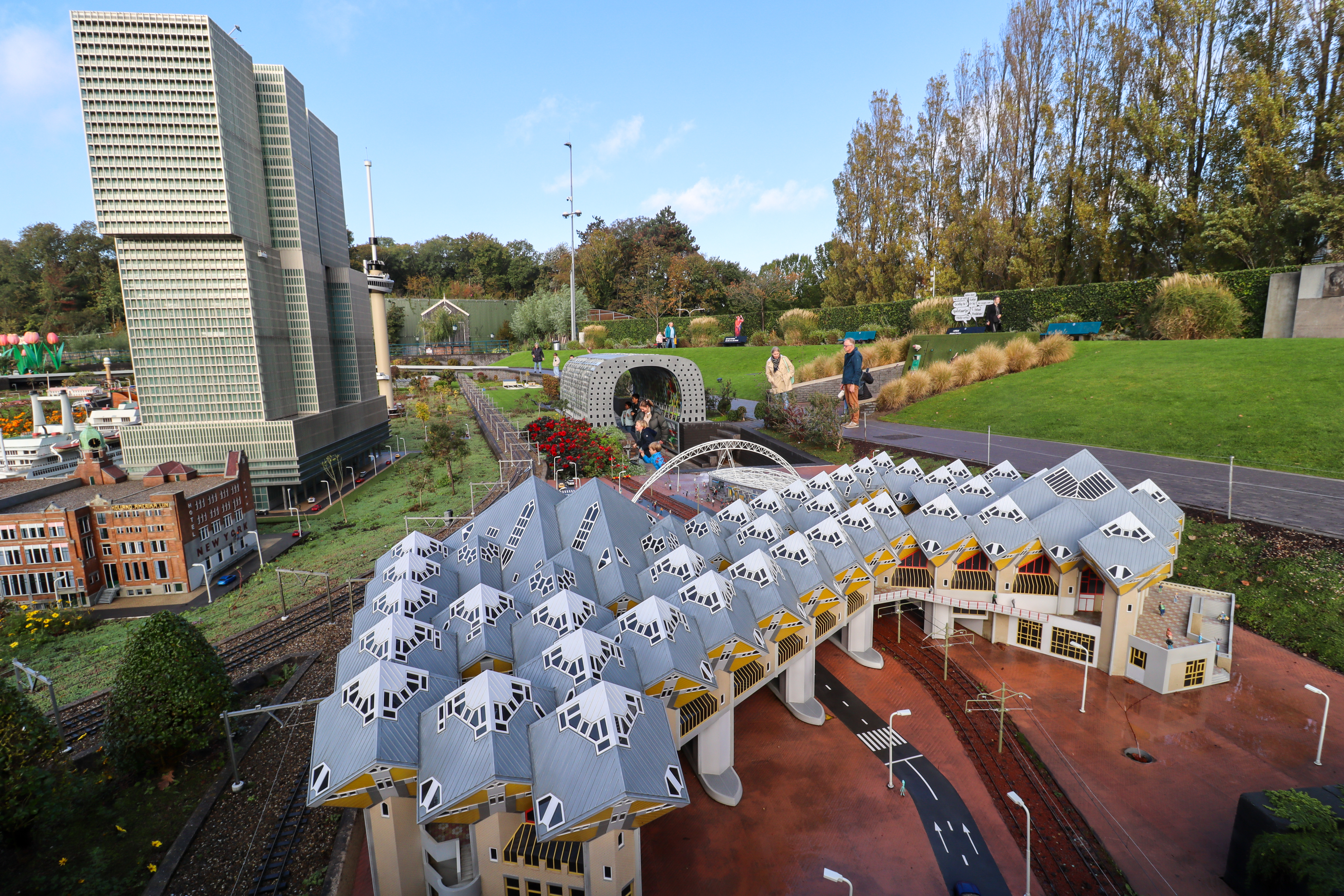
Parking for motorhomes at Madurodam is strange! It is free, which is amazing! However, it is rather difficult to find the way in. I'd been pre-warned by reviews of this, so we'd checked out the route in detail first. It was great though, once we got in.
I really enjoyed walking through the parkland to the Peace Palace. The park was quite forest-like, with paths winding between the trees. It allowed Liggy some off-lead time to relax and sniff her surroundings. It was totally away from the traffic, which I loved.
What was bad about The Hague?
Like Rotterdam, our main negative was parking. Parking at Madurodam was great but there is nowhere to park a motorhome anywhere near the city. There doesn't even appear to be anywhere you can park on the outskirts and get public transport back in.
Amsterdam
We're not really city people, so I didn't have huge expectations of Amsterdam. It just felt like we should at least have a look, as we were in the country. We stayed at a campsite on the outskirts of the city for three nights and used public transport to get to the attractions.
What was good about Amsterdam?
I have to start with the trams. I am a little... okay very nervous about using public transport. I avoid it like the plague. However, we didn't really have an option, so we had to try the trams. They were brilliant! I was able to board independently, the routes were easy to follow, wheelchair spaces were generally available and where people blocked them, they were told to move. My confidence grew enormously and by the time we left, we were hopping on and off trams quite happily!

Before travelling, I had researched how to pay for public transport and I discovered the I Amsterdam City Card ![]() . This turned out to be a really good option for us. You select how many days you want to pay for, and then activate it in an app on your phone. It was really easy.
. This turned out to be a really good option for us. You select how many days you want to pay for, and then activate it in an app on your phone. It was really easy.
The I Amsterdam card covered all our tram rides, but it also included free entry to many attractions and museums, plus a free canal boat tour and a cycle hire session. We weren't bothered about cycle hire, but the canal boat did appeal. I did loads of research and eventually discovered The Blue Boat Company ![]() , which is the only company offering wheelchair accessible canal tours.
, which is the only company offering wheelchair accessible canal tours.
Having made it by tram into Amsterdam, the canal tour was our first stop. We had to go to the booking office in person (because we were using the I AM card) and book a timeslot. This was very easy, and we got a space on our preferred tour. When we arrived to board, everything was great! The jetty was level and was easy to get onto. Then, at the back of the boat, there was a platform lift, to get me down to the passenger area. They helped us get a suitable table, which was close to their accessible toilet.

The tour lasted 90 minutes and was really relaxed and interesting. It was lovely to just sit and watch the world go by, with the audio guide giving information about Amsterdam as we passed various places. I would say this boat trip was one of the highlights of our whole week!
We found so many accessible places to visit in Amsterdam, that I don't have time to write about all of them. However, the A'DAM Lookout was another very enjoyable visit, and is worth a mention. We visited on our second day in Amsterdam and it was our first stop of the day. We took a tram to Central Station and then a ferry across the River Ij, which was very pleasant indeed. You can see the A'DAM tower from afar, so it was very easy to find.
The only negative about the A'DAM Lookout was the entrance. The ramps had a weird camber and the door wasn't level but had a significant lump to get over. After that though, it was brilliant! It was free with our I AM cards, the lifts were great, it had an accessible toilet. The lookout at the top was really spacious and easy to get around. We spent a good while there, just enjoying the views and the good weather.
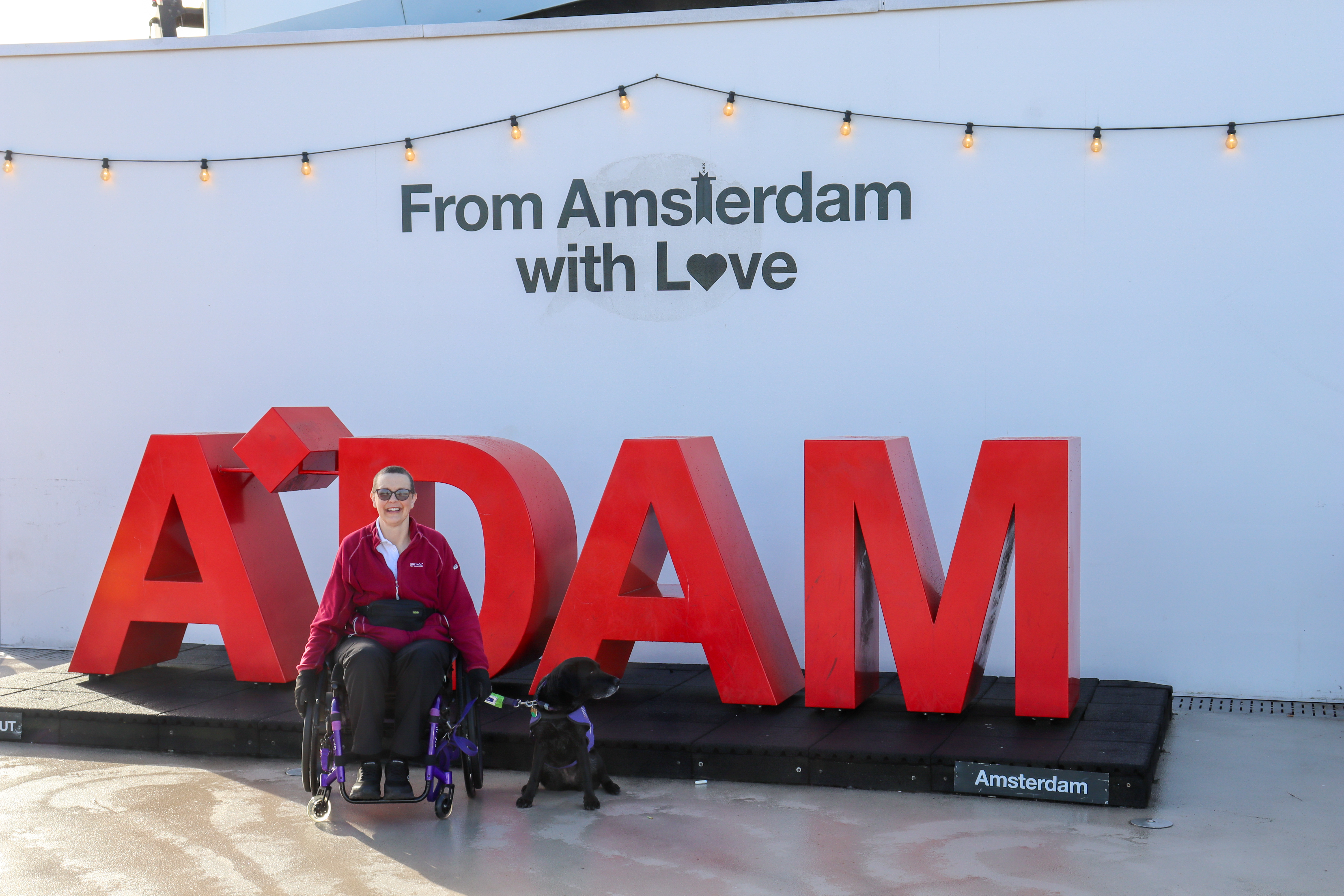
Other Amsterdam highlights were the Old Church and the Museum of the Canals. The latter looks totally inaccessible from outside, with steps up to the front entrance. The museum is in a traditional style canal side house. However, they have very cleverly built a platform lift into the steps that go to the basement. Inside, there's accessible toilets, a lift and the whole tour was really good!
What was bad about Amsterdam?
We stayed on a campsite, just outside the city centre. Camping Zeeburg was actually really lovely, and the site itself was accessible and had good facilities. However, getting from the site to the trams was not that easy. They state that it is a 5 minute walk to the tram stop, but they don't tell you that the tram stop is on a bridge and the only way up is via a flight of steps. So we couldn't use that tram stop and instead had a 20 minute walk each way to get to a different tram stop. Our biggest frustration with this was that the steps up to the bridge weren't even steep. They could have easily made it a ramp instead... especially given the apparent lack of rules around gradients!
Gouda
We had originally only planned a day trip to Gouda, whilst passing through from Edam to Kinderdijk. However, a storm caused us to review our plans. We didn't make it to Edam, but instead spent a couple of nights in Gouda.
What was good about Gouda?
Let's start with the aire, Camperplaats Hofstede Kloosterstein ![]() . We only booked on the day, as it was a sudden change of plans. Booking was easy and the site was very pleasant. The weather, less so! The site wasn't the easiest to find, partly due to a road closure in the village that was the usual route. However, we found an alternative, albeit through a residential estate and then along a rather pretty single track embankment road.
. We only booked on the day, as it was a sudden change of plans. Booking was easy and the site was very pleasant. The weather, less so! The site wasn't the easiest to find, partly due to a road closure in the village that was the usual route. However, we found an alternative, albeit through a residential estate and then along a rather pretty single track embankment road.
Gouda is probably best known for its namesake export, Gouda cheese. We visited the Gouda Cheese Experience, which was a lot of fun, highly interactive and very accessible.
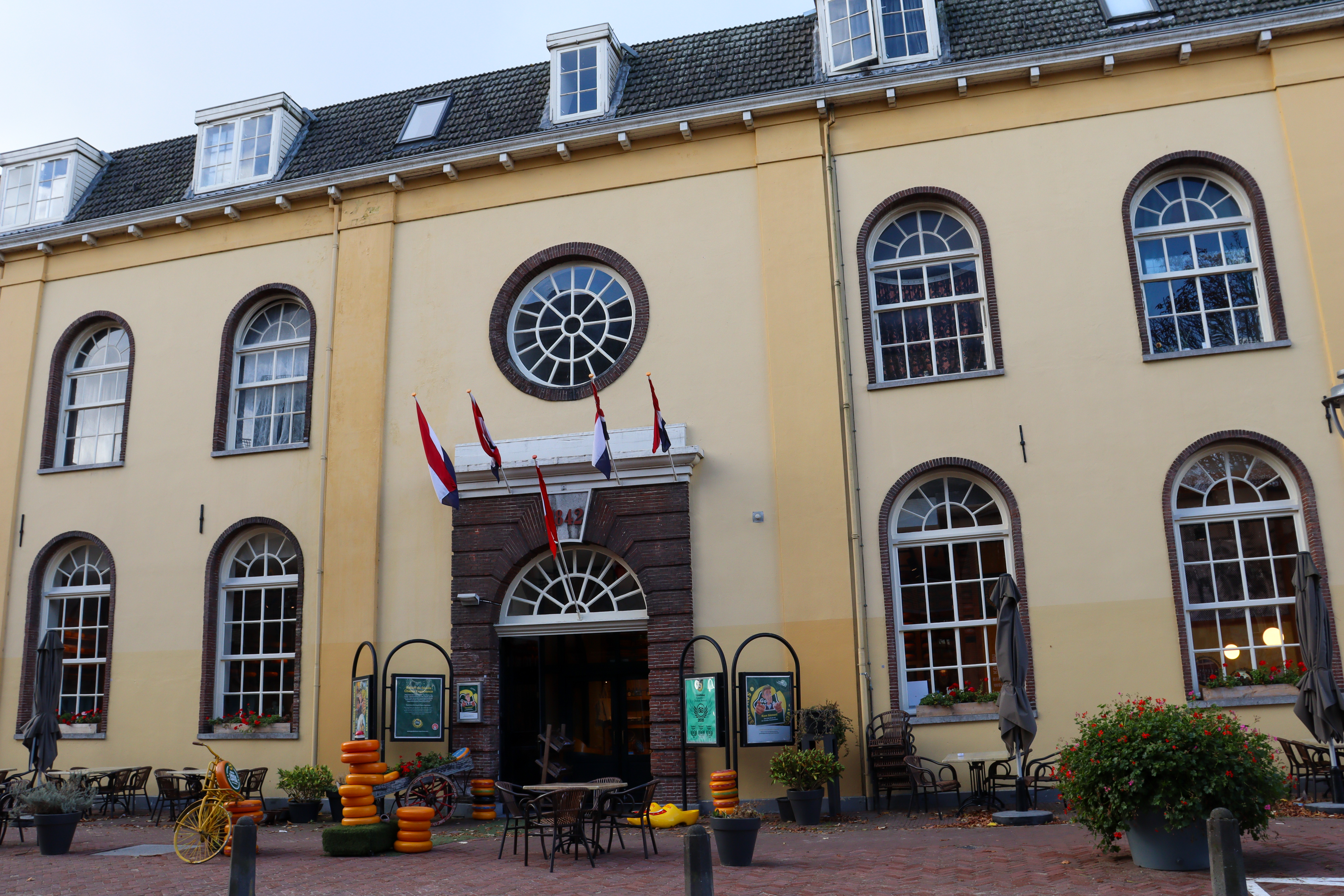
Like most attractions in the Netherlands, it all worked with an audio guide - a little telephone handset, programmed with multiple languages and lots of information. You scan QR codes or enter numbers as you go round the museum. This attraction also included tasting though. That was really good fun, though I think I got my pieces of cheese all in the wrong order.
What was bad about Gouda?
Having started the good with the aire we stayed at, I should start the bad with a place that was an aire but is no longer. Klein Amerika is in the town centre and is signposted all over town as a motorhome aire. We found it on Search4Sites ![]() , one of our two favourite planning tools. The page has now been updated to say no overnight parking, but this must be a recent thing. It was originally a designated place to stay, with some facilities and a payment system. But alas, no more.
, one of our two favourite planning tools. The page has now been updated to say no overnight parking, but this must be a recent thing. It was originally a designated place to stay, with some facilities and a payment system. But alas, no more.
Gouda was where we had our only really negative accessibility experience. The Syrup Waffle Experience sounded fun and they said it was accessible but actually, it wasn't. Neil ended up going round on his own, whilst I found an escape route with Liggy. The factory had stairs and the whole environment was utterly chaotic! I was more than happy to go and wait outside in the market square and wait for Neil to come back with a pack of syrup waffles from the shop.
Kinderdijk
Kinderdijk was our final destination on this road trip. With hindsight, I wish we had come here first, instead of Rotterdam. It would have been a much calmer and more beautiful start to the week.
What was good about Kinderdijk?
Kinderdijk is just a tranquil, pretty and enjoyable place to have a walk. The paths are all good quality, wide enough for a wheelchair and dog, with space to pass others. There is a visitor centre with a cafe, which is accessible and has toilets. The windmills are all originals and date back to the 1400s. We really enjoyed just walking and taking photos.
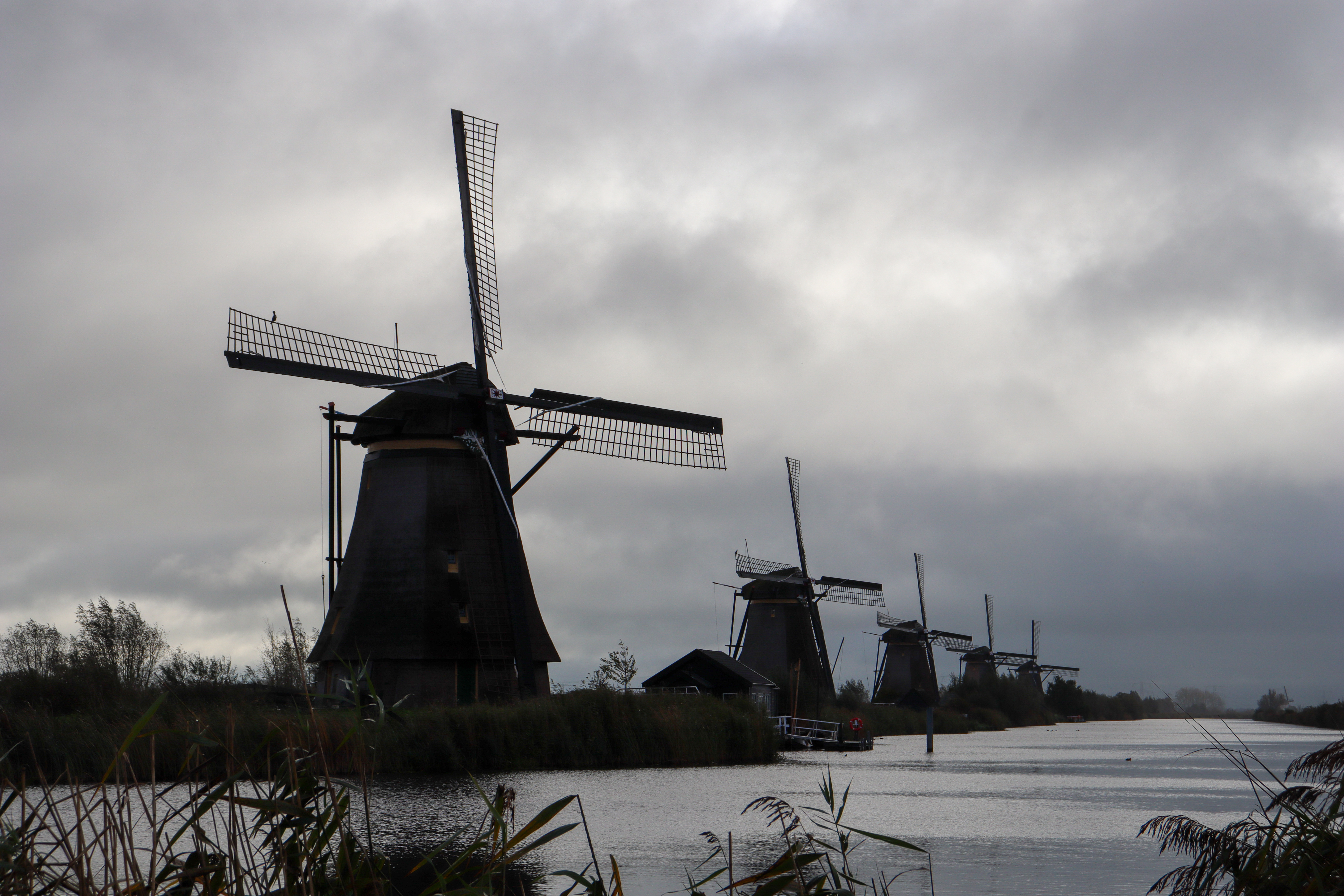
Another positive was the aire where we stayed, Camperpark Kinderdijk ![]() . It was very easy to find, well organised, clean and spacious. It isn't that close to Kinderdijk itself, but is the designated place for motorhomes to stay overnight. We walked to the visitor centre, which is just over 5km and took us about an hour each way.
. It was very easy to find, well organised, clean and spacious. It isn't that close to Kinderdijk itself, but is the designated place for motorhomes to stay overnight. We walked to the visitor centre, which is just over 5km and took us about an hour each way.
What was bad about Kinderdijk?
The weather! Okay, so that isn't really an accessibility issue and certainly not anyone's fault, but we picked a very wet and windy day to visit. Our walk in was okay, but on the way back, it poured down! That was made worse by a pretty catastrophic issue with my mountain trike. A piece came loose and got jammed in the chain. In getting it out, another piece got broken and the whole thing became unusable. Neil ended up pushing me all the way back. We were soaked and very cold!
Parking seems to be a theme for this holiday. Motorhomes can't park at the visitor centre in Kinderdijk. There is a designated motorhome car park, closer than the aire but at an additional cost of €9, on top of a mandatory entry ticket of €19.50 per person. So it would have cost us €48 to take this option. We decided it wasn't worth it. We didn't want to buy tickets, as most of the windmills and the museum are not wheelchair accessible. This didn't bother us, as we were happier just walking around the site and looking at the views, which you can do for free.
Summary
On the whole, we had a very enjoyable week and found the Netherlands to be quite good with wheelchair access and accessibility in general. Most places were fantastic with Liggy and it was only really the ferries where we had problems with her... which was only because she wasn't on the booking.
Our top 5 highlights were:
- Royal Delft
- The trams in Amsterdam
- Blue Boat canal tour
- Gouda Cheese Experience
- Seeing the Kinderdijk windmills
If we were to pick 3 moans, they would be:
- Lack of motorhome parking near to most places
- Ramps that were far too steep
- The P & O Ferry booking system!
Would we go again? Absolutely!
